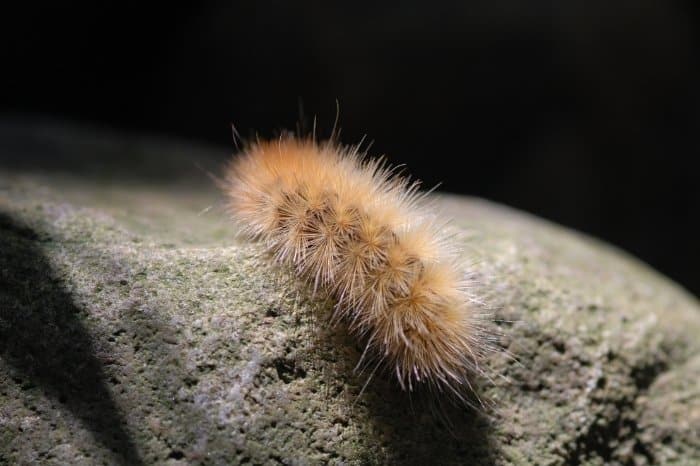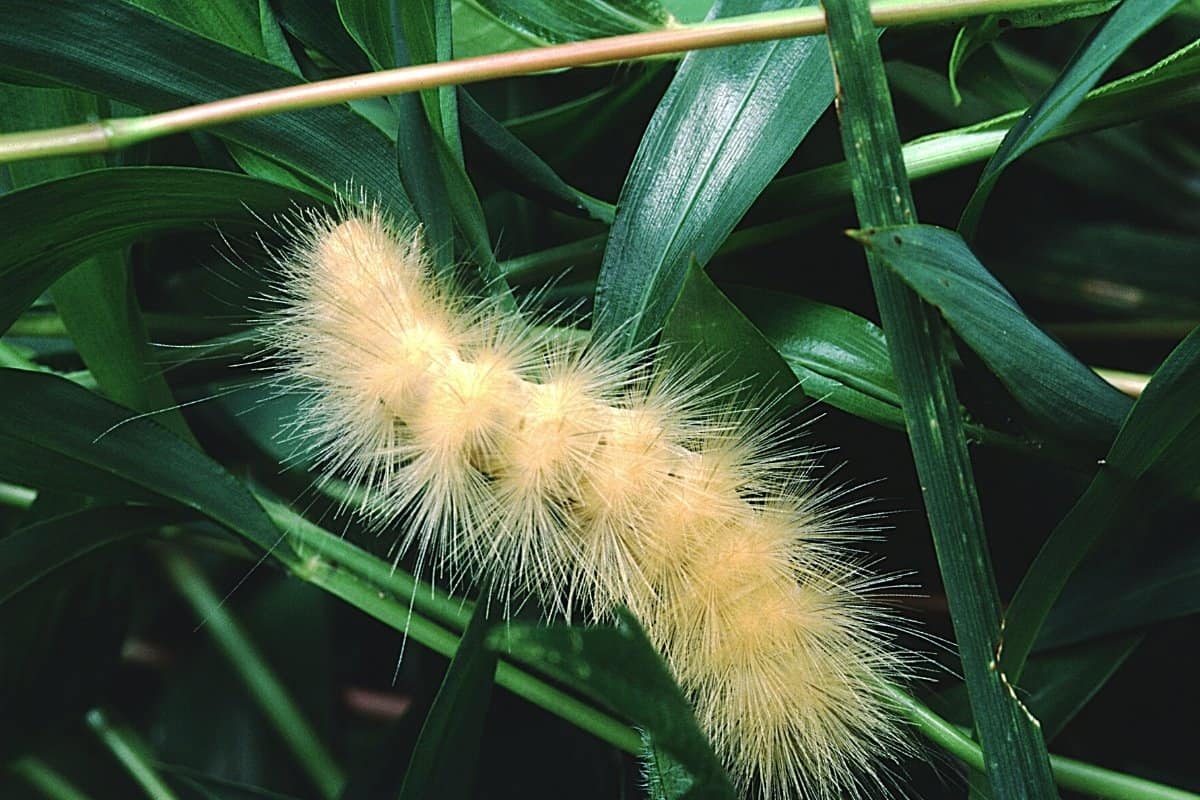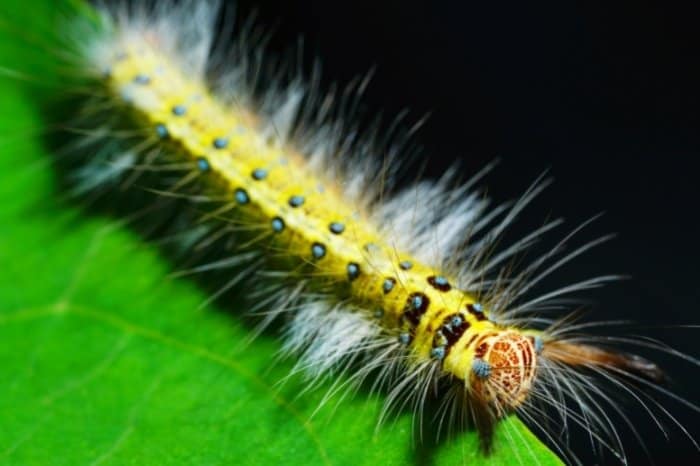Last Updated on February 27, 2023 by Griselda M.
What are white woolly bear caterpillars? Do these caterpillars do anything bad? What should we know about them? What should we know about wooly bear caterpillars in general? Read more to find out about these interesting creatures!
What are White Woolly Bear Caterpillars?
They are caterpillars of the hickory tussock moth, Lophocampa caryae. These moths emerge from the cocoons they overwintered in May-June and lay eggs on hickory and other deciduous leaf trees in North Eastern North America.
The caterpillars are also known as the white woolly caterpillar or white woolly worm. The caterpillar is white with a black line down its back. Some of them can be all white without the black line and are called albino woolly bear caterpillars.
Some appear to have tiny black spots instead of a black line; sometimes, the black line appears more like individual tufts than a line. This worm also has four small areas with a very thin cluster of black hairs longer than the rest of the fuzz. These are called pencils and are found on each corner of the body.

Calling it a wooly worm is in fact a misnomer – it is a caterpillar. As with all wooly caterpillars, it is covered in bristles. The hickory tussock caterpillar has been reported to cause a skin rash for some people when they brush against the wooly mass of bristles.
The caterpillars can eat quite a lot of leaves off the trees – but this tends to happen towards the end of summer going into fall, so it is not a big problem. After the caterpillars are fully grown they go to the ground and spin a cocoon hidden in the leaf litter. They pupate over winter and emerge as moths in spring to early summer. The moths are an important food for various forest birds, while the caterpillars are furry and inedible to most animals – although some animals have learned how to brush the bristles off before eating them.
Are Woolly Bear Caterpillars Endangered?
You can see the conservation status of the Isabella Tiger moth or banded woolly bear caterpillar across most of North America. It appears in general that the populations of this moth are secure and under no major threat. The other types in the US seem to be largely ok, but in the UK some are threatened.
This really depends on where you are. There appears to have been a major decline in certain types of wooly bear caterpillars, such as those common in the UK eg. the Garden Tiger moth, and Arctia caja, which is called a wooly bear in England. These appear to be almost non-existent now.
In the US, given the larger amount of less disturbed habitat, and the generalist feeding patterns of many common woolly bear caterpillar species, it appears that the general consensus is these are not as threatened. As with all things, even if something is not endangered, treat it as though it is – species can move quickly from stable populations to endangered. I try to conserve all indigenous insect biodiversity.
What Does a Woolly Bear Look Like?
Woolly bear caterpillars are the caterpillar life stage of a group of hawk moths. These caterpillars are characterized by being covered in hairy spikes that provide some level of protection to the caterpillar against predation.
There are a large array of woolly bear caterpillars and some are white, such as the white woolly bear caterpillar, with others being brown, black, having a red stripe, stripes down the sides with dots, grey, and a range of other colors. The spikes are generally not poisonous but can penetrate the skin and cause dermatitis as they are protein-based, and will trigger an immune response to their proteins, which in turn causes itching and swelling.
The Banded Tussock Moth – A good Example of a Woolly Bear
Another late summer or early fall caterpillar is the banded tussock (Halysidota tessellations), another hairy caterpillar.
Its larvae show variable color patterns, but it has mostly yellow or white hairy bodies. Its paired tufts of black and white bristles on the front and back and a tan to an orange horizontal line on its head tell it apart easily.
These caterpillars feed on the leaves of multiple shrubs and deciduous trees and shrubs. They are easy to find on the upper surfaces of leaves.
This species has only one generation, with mature caterpillars coming as early as July in the southern parts of Michigan state for example.
Woolly Worm or Woolly Bear Caterpillars
The woolly worm or woolly bear (Pyrrharctia isabella) is popularly known for its supposed weather prediction. It is the caterpillar that people tend to look for a weather forecast for the coming winter. The traditional story followed by many today says that the thickness of the rust-brown strips will predict the harshness or mildness of the coming winter.
Some caterpillars may lack brown stripes due to genetic diversity. Larvae are usually black, with a central brown stripe widening to a variable degree as the woolly bear grows into later life stages.
This woolly bear can have 2 generations annually, but the fall one is most noticeable. They will be all over looking for a protected location to spend winter. They love to spend winter under leaves or other plant debris.
When spring comes, the insect thaws and life resumes as normal. The woolly worms are about 2 inches long and have a diverse diet in the late summer and fall, consisting of grasses, leaves like birch or maple, flowers like clover, sunflowers, and asters. Their damage is minimal and hardly recognized.
Check this out:
American Dagger Moth
This caterpillar is either white or yellow, with five distinct tufts of long black hairs shooting from its body, attracting attention every fall.
The American dagger moth (Acronicta Americana) loves to rest on the lower side of the leaves with its head curled over to one side. This behavior differentiates them from the banded tussock moth caterpillar that rests on the upper leaf surface.
SUMMIT 021-6 Caterpillar and Webworm Control-Hose End, 1-, Quart
They feed on various hardwood tree species and are commonly found in forests or among trees in the backyard, starting from August to October. They are not known to cause economic damage to plants.
What to Do When You Encounter These Hairy Caterpillars
Can you touch a woolly bear caterpillar?
Now that we all know they appear in the fall, it’s best to avoid touching them by all means. Some hairy caterpillars are known to have urticating hairs that penetrate the skin with ease.
These hairs can break off easily and puncture your skin, causing mild irritation. Remember, the hairs are microscopic and cannot be easily seen on your skin.
Some people experience severe allergic reactions after coming into contact with these worms. The degree of severity depends on an individual human’s physiology. Each time you are exposed to a foreign protein, your body mounts a stronger immune response to it – if the body fails to regulate this response with time, it can become an allergy.
The irritation they cause to humans is a natural defense mechanism against their predators. Overall, do not touch these caterpillars, no matter how pretty they may look to you.
If you must touch them, put on a pair of gloves first before touching them.
What Does a White Woolly Caterpillar Mean?
These are the larval stage of the Hickory Tussock moth – Lophocampa caryae. They are covered in furry “hair” that is defensive – it is spikey and will break off in your skin irritating it. With repeated exposure to these woolly hairs, some people can develop skin allergies that cause red skin reactions.
Should You Kill a Woolly Bear Caterpillar?
No. They are an important part of the natural ecosystem.
How Long Do Woolly Bear Caterpillars Live?
The eggs laid by adults hatch in the fall, and the larval caterpillar stages overwinter and then emerge the next season to complete their lifecycle, metamorphosis, and emerge as adult moths that can lay eggs. Depending on how long your winter is, will govern the total life of the species. But work on 6-8 months of being alive (quite a bit of that being frozen).
They have a curious ability to allow their body to freeze slowly in such a way that it is not damaged in the caterpillar stage. In the case of the Arctic Wooly Bear Caterpillar, the growing season is really short. These caterpillars can therefore undergo a growth cycle where they can freeze and then thaw and get a bit of time in to eat and grow, and then freeze again. This means that they can take 7-13 years to make it from the caterpillar to the adult stage. The majority of this time they are however frozen.
Do White Fuzzy Caterpillars Turn into Butterflies?
Generally, they turn into moths. These are similar to butterflies except their wings fold back and they often have a nocturnal nature. We tend to notice butterflies a lot more as they flutter around on flowers during the day. Moths are more difficult to notice as they are often not seen as much because of their nocturnal nature.
Where Do You Place a Woolly Bear Caterpillar?
Generally, just leave it where it is. They have little bristles that can break off and penetrate your skin – with time your body can develop an allergy to these and you will get an itchy patch. They have a wide range of plant species they can eat, so if you find one on some concrete, you can pick it up using a leaf and put it in a clump of bushes.
How Big Do Woolly Bear Caterpillars Get?
The caterpillars will grow to about 2 inches in length before they spin a cocoon and metamorphosis allows them to turn into adults. This is a general rule and there is quite a bit of variation around this size.
Conclusion
Nature is beautiful! And to see these white woolly bear caterpillars, and their relatives, in various colors confirms how breathtaking nature is.
Human interruption is what causes these and other important creatures to diminish on planet earth. Enjoy their presence and look out for the beautiful adult moths.
Avoid exposure to the spikes, as repeated exposure can cause a mild allergy. After touching a woolly bear once or twice you should feel no strong urge to touch one again – they are not cuddly at all, and the hairs hurt sensitive skin. I remember this disappointment as a kid, and that was 40 years ago! The caterpillar looked so cuddly, but it was not.
FAQs
What happens if you touch a wooly bear caterpillar?
A caterpillar’s skin is actually made of many small hairs called setae (pronounced “set-a-AY”).
These setae are incredibly flexible, and when the caterpillar is moving, it can use these hairs to stick to surfaces or other objects. The setae on a caterpillar’s back are arranged in rows, and each row contains a different kind of setae.
Some people have allergic reactions to caterpillars that are common in their area.
What does woolly bear caterpillar turn into?
It's a cocoon. The pupa stage lasts from about 2 weeks to 6 months, depending on the species. During that time it's a cocoon and doesn't look like anything else. After that time, the chrysalis emerges as a moths.
The woolly bear caterpillar is a larva of the tussock moth (Oecophora bractella). It is now found throughout much of Europe and North America, as well as in New Zealand and Australia. The caterpillar has a brownish-grey body with a grey head. The body is covered by long hairs, which are also present on the head.
Are woolly bear caterpillars harmful?
The woolly bear caterpillar, a large brown moth with white spots on its back, can be found throughout the southeastern United States. It is not known to cause any serious problems for humans or their pets. However, if you come across a woolly bear caterpillar, try to avoid handling it, and remove it from your property immediately.
The woolly bear caterpillar is not known to carry any diseases that pose a health threat to humans. If you find it on your lawn or in your home, it will probably leave by feeding on flowers or other plant material. Do not touch it or allow it to escape onto your property. Remove it from your lawn or other plants as soon as possible.
What do woolly bear caterpillars like to eat?
They are omnivorous, but usually eat more insects than plants. They are omnivorous and feed on a variety of foods. They primarily eat insects, but will eat plants, berries, fungi, small animals, birds, and eggs. But they are not just eating insects; they are also eating other small invertebrates such as worms and ants. The caterpillars of the brown bear, Ursus arctos, live in groups on the ground, where they forage for food.
Can you pick up a woolly bear caterpillar?
Yes, you can pick up a woolly bear caterpillar. Woolly bear caterpillars are the largest caterpillar in North America.
Can you keep a woolly bear caterpillar as a pet?
Yes, you can keep a woolly bear caterpillar (Pycnoscelus) as a pet. They are not a moth, but they do have wings. They are native to North America, and are commonly found in the forests of the eastern half of the continent. It is possible that you will be able to find one in your area.
If you feed it, it will eventually pupate and become a butterfly.
They are usually nocturnal feeders, but they are also known to eat fruits and berries, as well as flowers. If you take care of them properly, they will grow into very large, fuzzy creatures. They will be about the size of a human thumb, and their skin will be about the thickness of a pencil lead.
Caroline is a gardener who loves to get down to the nitty–gritty of gardening. She proudly proclaims herself as a ‘dirt worshipper‘ and can often be found deep in the garden, covered in soil and singing to her plants. As a self–proclaimed ‘plant whisperer‘, Caroline believes that plants need love and attention just like any other living thing, and she loves to give them both. When she‘s not tending to her garden, you can often find her researching the latest gardening trends, or teaching others how to make their gardens thrive




